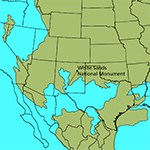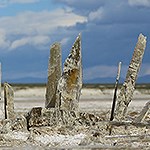|
A curious white line on the horizon, White Sands has long sparked wonder in people passing through the Tularosa Basin. Standing on top of a dune overlooking this sea of sand, it can be difficult to imagine where all the brilliant white sand came from. To understand the origins of the world’s largest gypsum dunefield, we must look back over millions of years during which just the right geologic and climatic processes took place in just the right order. Many of these processes continue today, allowing us to witness the formation of these unusual sands.

NPS Photo The story of the world’s largest gypsum dunefield began 280 million years ago when the Permian Sea covered this area and gypsum settled on the sea floor. The formation of the dunefield continues today in an endless cycle of erosion and renewal. 
NPS Photo When it comes to sand, size is all that matters. That is because sand is defined as any mineral between .065 millimeters and 2 millimeters in diameter, which is about the width of a nickel. Any mineral? Now that opens up some interesting options. 
NPS Photo Gypsum is a common mineral found all over the world. It is used in products from wallboard to beer. Gypsum is rarely found in sand form making the 275-square mile dunefield a one-of-a-kind natural wonder. |
Last updated: May 29, 2024
